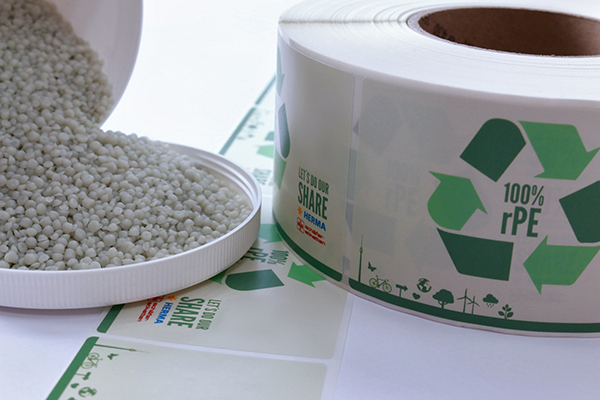Labelexpo: New Labelstock for Flagship Products
- Published: August 22, 2023

What makes a self-adhesive label material as sustainable as possible? How does it mostly conserve valuable resources? In response, HERMA is presenting a new labelstock at Labelexpo 2023. Its three main components – A PE film label material made of post-consumer recycled material, an adhesive without a carbon footprint and a new type of release liner – were selected and combined with the greatest possible sustainability in mind (Hall 5, Stand C14).
"This new self-adhesive material shows what is already possible in practice today. It is neither a concept study nor a feasibility study, but a product that is now available, for example, for sustainable flagship projects with labels," said Marcus Gablowski, Chief Sustainability Officer at HERMA. HERMA rPE PCR white (grade 856) is used as the label material for the new self-adhesive material. Only post-consumer recycled (PCR) plastic is used in the production of this white PE film. This is based, for example, on actual end-user waste, which has risen sharply in recent decades – without the addition of new granulate. The origin of the label material is visibly recognizable by means of the so-called specks. The new label stock is therefore ideal for very attractive labels that underline the recycled design and are preferably used on PE surfaces. "The use of a recycled plastic in a new product is another contribution that HERMA is making to support meaningful material cycles," explains Gablowski. "The film material also shows how important it is to overcome the convenient throw-away mentality. Since we are only at the beginning of the circular economy as a society."
Environmental benefits without compromising on quality
The new adhesive 72F has been developed jointly by HERMA and BASF for this self-adhesive material. It is an adhesive that does not produce a carbon footprint (zero PCF) from its cradle to the BASF factory gate. According to the so-called biomass balance approach, the raw materials required for its production are partly based on biomass from organic waste instead of fossil raw materials. During their growth phase, the appropriate plants have removed the climate-damaging CO2 from the atmosphere in recent times. TÜV Rheinland Energy GmbH, an independent certification body, has confirmed the PCF calculation for the adhesive used by BASF. On the product side, the new adhesive 72F combines a high tack with very high cohesion and excellent final adhesion. "This means that the adhesive offers environmental benefits without the need for label printers and users to compromise on quality," said Gablowski.
The innovative paper backing material, which is being used for the first time here worldwide, also contributes to the lowest possible consumption of resources. Details of this are still subject to confidentiality. "However, we will be announcing details during Labelexpo," said Gablowski. "We are pleased to once again extend the limits of sustainable label activities with the new self-adhesive material."



